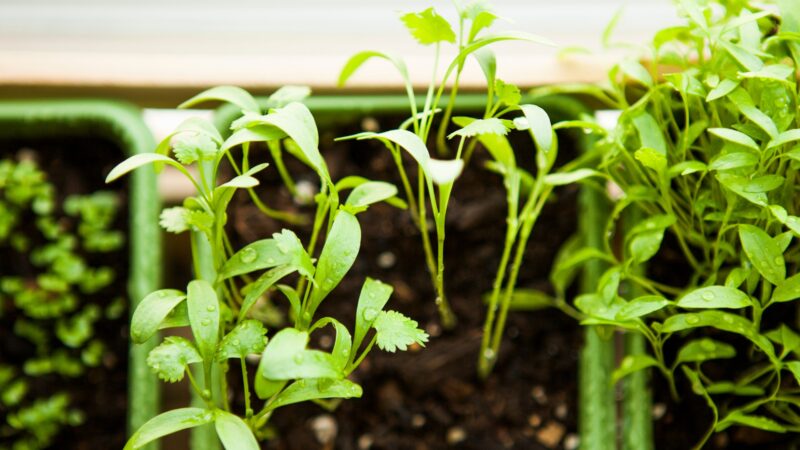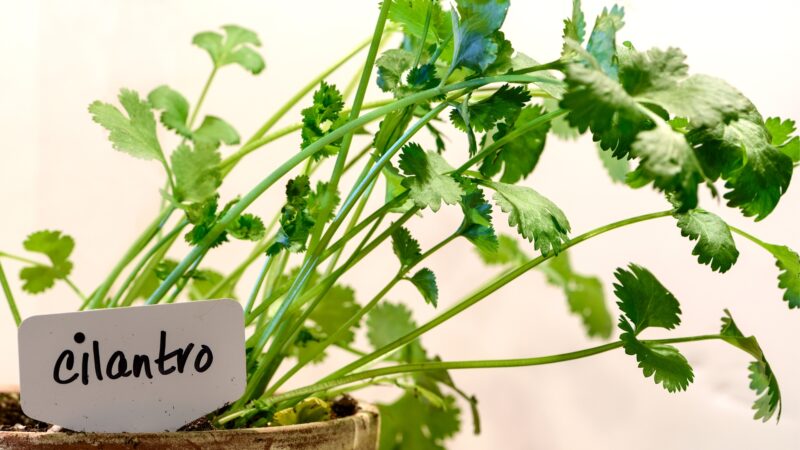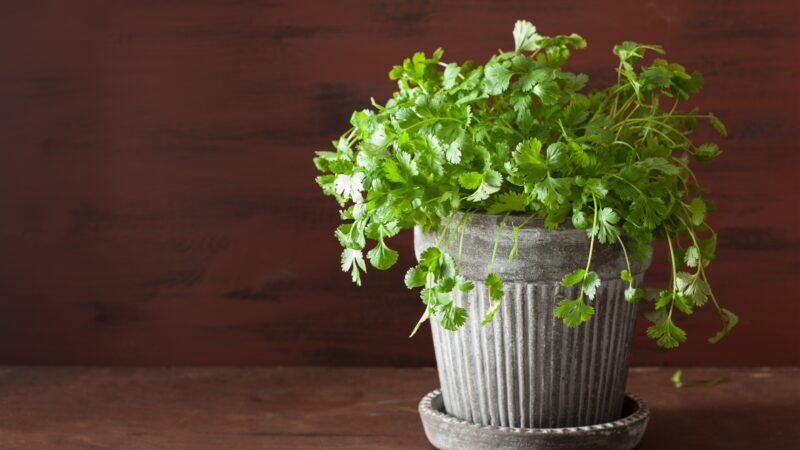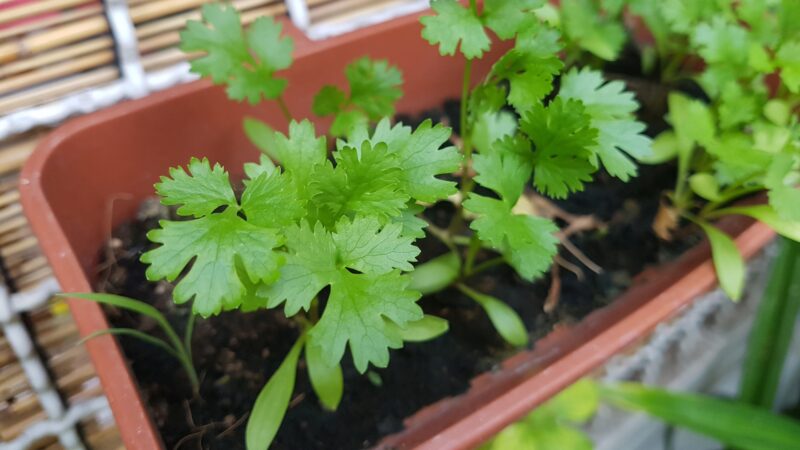Cilantro is a cool-season culinary herb that is relatively easy to grow since it establishes quickly, roughly only three months after planting, as long as the optimum environmental conditions are achieved.
Cilantro can be planted by directly sowing seeds into garden beds or containers, as well as by vegetatively propagated from cuttings. Use soil that is soft, well-tilled, well-draining, and amended with composted organic matter. Adding vermiculite into the rooting medium can also help it grow healthy.
To know more about growing cilantro, when and where to plant it, how to harvest it, what are the various pests and diseases to look out for, and other interesting information, simply read further this article!
What Is Cilantro?

Cilantro (Coriandrum sativum) is a fast-growing, pungent culinary herb belonging to the parsley family. The entire plant is edible, but the seeds, usually referred to as coriander and leaves, are the most frequently used. It is also used in traditional herbal medicine and has been cultivated since ancient times.
Additionally, it is characterized by having wide, flat leaves with a tendency to bolt in hot weather. It grows 12 to 18 inches in height and produces clusters of pale pink or white flowers. Cilantro only has a few cultivars commercially available.
Is Cilantro Easy to Grow?
Cilantro is an easy-to-grow herb since it can be planted under a wide variety of climatic and soil conditions. It is often produced commercially in both small- and large-scale farming operations worldwide.
Where to Plant Cilantro?

Although cilantro can be grown on a variety of soil types, it performs best in well-drained, moderately fertile, sandy, or loam soil under full sunlight, but it can also tolerate very light shade. Ideal temperatures are between 50°F to 85°F.
When to Plant Cilantro?
Cilantro can be planted all year round, so it depends on when you want to harvest it. Plant cilantro in the late winter to early spring season if you desire a spring crop, late summer to the early fall season for a fall crop, and late fall season for a winter crop. Summer plantings are generally not recommended since the weather will cause the plants to bolt.
How Long Does Cilantro Take to Grow?
The growing season for cilantro usually takes at least 100 days when provided great care, but its foliage is ready to be harvested within 45 to 80 days after planting.
Can Cilantro Be Grown From Seed?
Cilantro is typically grown by directly sowing seeds in garden beds and other landscapes.
How to Grow Cilantro From Seed?
Step 1: Prepare your garden bed. The soil must be soft, well-tilled, and amended with 2 to 4 inches of composted organic matter per 25 square feet of planting area. The garden bed itself should be around 40 to 80 inches wide.
Step 2: If you plan to harvest cilantro leaves, set the seeds in the bed 2 inches apart. If you plan to harvest its seeds, set the seeds 8 inches apart. The seed should be incorporated ¼ to ½ inches deep into the soil.
Step 3: Regularly water the seedlings about an inch weekly throughout the growing season. Avoid overwatering, as the plant does not tolerate humid or damp conditions.
Step 4: Fertilize 1 to 2 times during the growing season. Use a ¼ cup of a nitrogen-based fertilizer per 25 square feet or ½ teaspoon of ammonium nitrate or urea per square foot of planting area.
Step 5: Sow at 2 to 3-week intervals for a longer harvesting period.
Step 6: To control weeds postemergence, use a mixture of clove oil d-limonene, and 20% vinegar cinnamon. Hand weeding may also be utilized.
Can I Grow Cilantro From Cuttings?
You can grow cilantro from cuttings. However, this method is generally unreliable as it may not always result in the plant growing roots from the cuttings.
How to Grow Cilantro From Stem Cutting?
Step 1: Select cuttings from a disease-free cilantro plant in the early morning when the plant is fully turgid. Lateral shoots generally root better than terminal shoots.
Step 2: Use a sterilized, sharp cutting tool and make 4 to 6-inch cuttings. Remove leaves, flowers, and flower buds from the lower one-third to one-half of the cutting.
Step 3: Treat the cuttings using the rooting hormone. Tap the cuttings to remove any excess hormone when you’re using a powdered product.
Step 4: Insert one-third to one-half of the length of the cuttings into a sterile, well-draining rooting medium or garden bed. Do not place directly into a landscape. The buds should be pointed up and the stem should be vertical.
Step 5: Water the medium and make sure it receives indirect light. The soil should be kept sufficiently moist but not wet until the cuttings start rooting.
Step 6: Once the plant has reached its mature size, you can now transplant it into a landscape or other permanent locations.
Can You Grow Cilantro in a Pot?

Cilantro can be planted in a pot and other containers indoors before transplanting outdoors.
How to Grow Cilantro in Pot?
Step 1: Select a porous or semi-porous pot. This can be made of clay, terracotta, or unglazed ceramic. It should have drainage holes on the bottom, as well as a saucer to catch excess water.
Step 2: Fill the pot with ¾ of well-draining, moderately fertile soil. You can purchase a seed-starting soil blend commercially. Make sure the soil is leveled and thoroughly soaked with water.
Step 3: Lightly press the soil to create tiny, shallow furrows that are 2 inches apart each. You can choose to fill the furrow with some vermiculite so that the plant will be easier to remove later on when transplanting. Insert the seeds inside the furrows.
Step 4: Place the pot in a shallow pan of water so that water can be absorbed through the drainage holes after the seeds have been sown.
Step 5: Once the moisture has risen to dampen the surface of the soil, move the container to a warm location with bright but indirect light (i.e. curtain-filtered). Cover the pot with plastic wrap to raise the humidity levels. Remove it once the seedlings begin to germinate.
Step 6: Apply liquid fertilizer once two mature leaves have emerged. Dilute it to one-fourth its strength.
Step 7: Transplant the cilantro as soon as it has filled its container and has a robust root system.
How to Harvest Cilantro?
Cilantro is harvested when the leaves have reached a length of about 6 inches. Harvest is done by cutting the plants either below the soil surface or at 1.5 to 2 inches above the crown. After selecting leaves, you can tie them together with a twist tie or rubber band, or you can pack them in plastic bags.
Seeds should be harvested after the plant has flowered and the seed heads are brown in color. To harvest, simply place the plant inside a bag and let it dry until the seeds start falling off.
Cilantro Pests and Diseases

PESTS
1. Weeds
- Symptoms: The plant germinates slowly and is not competitive against weeds
- Solution: Preplant weed control by crop rotation, using pre-irrigation, and shallow cultivation is the best solution since post-emergent herbicides are not effective.
2. Beet armyworms
- Symptoms: Leaves are stunted and have signs of feeding, resulting in significant crop loss. Frass on the leaves is also another sign.
- Solution: Disc the fields after harvest to remove any food sources for the remaining larvae. Destroy weeds along the borders of the planted fields. Applications of spinosad and Bacillus thuringiensis can also work.
3. Cabbage Looper
- Symptoms: Damage to and skeletonizing of new leaves, cotyledons, and terminal buds. Eggs, remains, and frass will be found on the undersides of younger leaves.
- Solution: Selective chemical insecticide sprays, insecticidal soaps, and oils can be used to suffocate and kill the caterpillars. Ingredients to look out for are pyrethrin, azadirachtin, spinosad, malathion, or neem oil.
4. Green Peach Aphid
- Symptoms: Stunting and leaf twisting and curling. They also secrete honeydew which becomes sooty mold, reducing crop marketability. They are also vectors of over 100 different viral plant diseases.
- Solution: Remove weedy species and infested culls around the garden bed. Destroy any crop residue after harvesting. Applications of entomopathogenic fungi, neem oil, azadirachtin, and insecticidal soaps can also work, however, the insects may develop resistance against pesticides.
5. Willow-Carrot Aphid
- Symptoms: Causes leaves to stunt and curl as well as turn black due to the sooty mold they secrete. They are also vectors of viral plant diseases.
- Solution: Destroy and dispose of infested crops immediately after harvest to prevent further dispersal of the insects. Apply pesticides to the tops and undersides of the leaves, preferably products that contain azadirachtin, bifenthrin, or capsaicin. Insecticidal soaps containing spinosad can also work.
DISEASES
1. Bacterial Leaf Spot
- Symptoms: Small, water-soaked lesions on the leaves which develop into brown or black spots. Blighting of foliage can also be observed.
- Solution: Crop rotation, avoid excessive application of fertilizers containing nitrogen, and using drip or furrow irrigation are ideal cultural controls. Products containing copper are the only registered chemical treatments for this pathogen.
2. Cilantro Yellow Blotch
- Symptoms: As the name suggests, the leaves of the plant will develop bright yellow, blotchy, irregularly shaped lesions.
- Solution: Only cultural control, by planting the cilantro in well-draining soils and disinfecting gardening equipment, is the available treatment option as of this writing.
3. Powdery Mildew
- Symptoms: Powdery growth on petioles, leaves, flower stalks, and bracts. Leaves may become chlorotic and flowers become distorted.
- Solution: Applications of sulfur can be used against infection that has been detected early in the growing season.
List of Sources
Cilantro Production in California – https://anrcatalog.ucanr.edu/pdf/7236.pdf
Cilantro and Parsley – https://ipm.ucanr.edu/agriculture/cilantro-and-parsley/